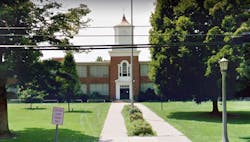Renovated Pennsylvania middle school gets LEED Gold rating
The $44 million renovation of Pennwood Middle School in the Pennsbury (Pa.) District has received LEED Gold certification from the U.S. Green Building Council for its environmentally friendly design and construction.
The district says in a news release that by seeking the LEED Certification, it has earned a $2 million grant from Pennsylvania's Department of Community and Economic Development.
The school’s renovation began in 2016 and was completed in August 2018.
Built in 1951 as the first high school in the Pennsbury district, Pennwood is considered something of a local landmark with countless community ties. It is one of three district middle schools.
The Pennwood Middle School project consisted of a renovation to the existing 190,000-square-foot school and a classroom addition of 8,000 square feet.
Among the sustainable elements that contributed to its LEED Gold rating:
•Reused 95 percent of the existing structural elements of the building.
•The building is in a neighborhood where students can walk or bike to school. Bike racks, showers and changing rooms were provided to reduce carbon footprint.
•Improvements to the building’s envelope, windows, roofing, and lighting controls, as well as installing a new high-efficiency, fully-controllable HVAC system, have reduced energy consumption, improved indoor air quality, lighting and acoustics, and enhanced teaching spaces.
•Parking is provided for low-emitting & fuel-efficient vehicles.
•Low-flow toilets, automatic faucets, and water efficient landscaping have reduced water usage by more than 20%.
•The school-owned auditorium, gymnasium, cafeteria, classrooms, playing fields and parking are shared with the surrounding community.
•25% of the building materials were locally sourced, and 26% were manufactured using recycled materials.
•The use of water soluble products has reduced off-gassing of volatile organic compounds in sealants and glues.
•Onsite recycling efforts helped the project team divert 95% of construction waste away from landfills and into recycling centers.
The project was designed and engineered by Remington & Vernick Engineers, and the construction manager was D’Huy Engineering.
About the Author
Mike Kennedy
Senior Editor
Mike Kennedy, senior editor, has written for AS&U on a wide range of educational issues since 1999.
